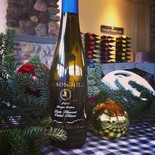A Finger Lakes Winemaker Returns to the comforts of France
A couple of weeks ago, I was able to visit my family in France. It was very relaxing to be able to spend some time with my family and close friends. It has been a gastronomic adventure. Every year, I make a point visiting some friends in an overnight stay. My friends work in the vineyard industry and distillery industry. Interestingly enough, we met twelve years ago…on Long Island, NY. And we realized we were from nearby villages in Languedoc. We have been in a few interesting places through the years, and this time it was a buffet, “French Style”: all you can eat foie gras, smoked salmon, shrimp cooked in many different styles, and a variety of other French specialties. I had to have frog legs of course! One of my plates (and there were a few!), had most of the “delicacies” I miss in the US: tripes, veal kidneys, chicken hearts and quail; the “vegetables” were sautéed mushrooms with potatoes (no room to waste with greens that evening!). And to pair with it, we had bottles of a local red wine from the “Abbaye de Fonfroide”, a medieval monastery. Although I wish I would have been able to share a bottle of Heron Hill Blaufrankisch with my friends. As you can see, I also stacked on some iconic French desserts: I love Canelés, and “Baba au Rhum” has been one of my favorite desserts since my childhood. We stuck with our trusty red for dessert, but Heron Hill Late Harvest Vidal Blanc would have paired perfectly with both desserts. Oh and I had to sneak in some more cheeses even on my dessert platter!
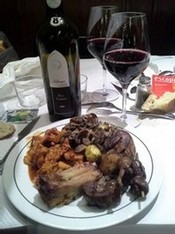
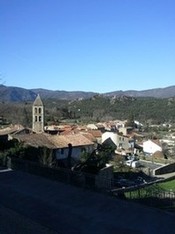
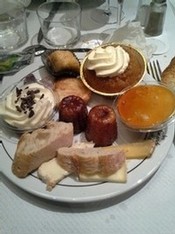
A few days after this food orgy (no, it was not an overdose…), I went with my family to an exclusive restaurant lost in a tiny village in the back country, called l’Ortensia, in Saint-Gervais-Sur-Mare: wonderful landscape and amazing food, focusing on nature-friendly local farmers. We had fresh foie gras (I can’t have enough of it…), perfectly cooked scallops duo with beets and a spicy lemon gelée. The main course was veal tenderloin with crispy bacon, homemade potato chips, Brussels’ sprouts and salsify served with a green pea purée. It was just exquisite. To accompany most of our meal, we had a Côtes du Roussillon called “Les Sorcières”, which means “The Witches”. It was a young wine, very rich and fruity with bold tannins: a delicious match.
My wife could not accompany me this time around...so I promised her we will visit l’Ortensia next yea!
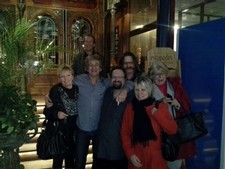
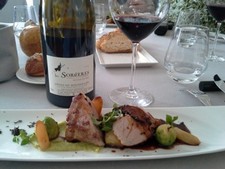
The Culmination of Harvest and a Hot Holiday Recipe
The 2013 harvest is over, after we picked the Riesling Icewine on the third week of November at Ingle Vineyard on a cool site overlooking the west side of Canandaigua Lake. Yes, it got that cold before Thanksgiving! The 2013 whites are either done with the alcoholic fermentation or finishing it slowly. A cool fermentation for white wines helps preserve the aromas from the varietal and also from the fermentation itself. A cool temperature means a long and slow fermentation.


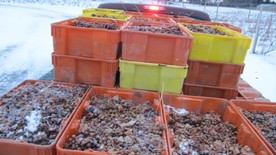 (Scenes from harvesting Riesling for icewine)
(Scenes from harvesting Riesling for icewine)
The reds need a higher temperature during the alcoholic fermentation to help the extraction of tannins from the skin and seeds. The alcoholic fermentation is therefore much quicker, a matter of days to a week. The rest of the time spent on the skin is called post-fermentation maceration. The red wines have been pressed off the skin and are now going through the secondary fermentation, or Malo-lactic fermentation: malo-lactic bacteria transform the sharp malic acid (found in apples) into the softer lactic acid (found in yogurt). This makes the red wines softer and rounder. Our white wines do not go through Malo-lactic fermentation in order to preserve their natural acidity.
For me, Christmas is a family holiday, in contrast with the New Year celebration which is more of a “friends get-together.” It has been a tradition for my wife and I to spend Christmas Eve with her cousins on Long Island for the “Feast of the Seven Fishes.” You might have guessed it: they are on the Italian side of the Family. As the name suggests, all the dishes are seafood based: shrimp cocktail, baked clams, broiled lobster tails, clams in a white wine sauce over pasta…and lots of desserts!
(Heron Hill Vidal Blanc 2011: Gold medal Finger Lakes International Wine Comp.; 90 points Wine & Spirits)
Interestingly enough, we bring the wines: Heron Hill Muscat is a favorite, along with the Semi-Dry Riesling and Ingle Vineyard Riesling. For the red wine drinkers, Heron Hill Cabernet Franc is always a hit, and I might add our Blaufränkisch or Baco Noir Reserve this year along with Eclipse Red 2010. And for dessert, I better not forget Heron Hill Late Harvest! It is a very versatile wine and pairs with many different desserts, as long as the dessert is not overly sweet. An interesting dessert to pair the Heron Hill Late Harvest Vidal Blanc with is a Ricotta cheese filled crêpe flambée. I believe I have shared a flambée Shrimp recipe in the past: you are going to think I am a pyromaniac…well, it surely makes a good show!
Crêpes Flambées with Ricotta cheese filling
For Crêpes:
¾ cup flour
1 cup milk
3 eggs
¼ cup vegetable oil
¼ tsp salt
1 Tbsp sugar
¼ tsp Vanilla extract
For Filling:
400g Ricotta cheese
4-5 Tbsp confectionated sugar
1 ½ tsp lemon zest
1/3 cup orange juice
¼ tsp Vanilla extract
For Flambée:
1/3 cup of either whiskey, dark Rum, aged Brandy, Cointreau,
or Grand Marnier (for a “Crêpe Suzette” approach).
TO PREPARE:
First, blend all the ingredients for the crêpe batter together, then store in the refrigerator for about three hours. This gives you plenty of time to make the filling, which should be made before cooking the crêpes. Just blend all the ingredients together. I chose Ricotta cheese for its creaminess and its lighter taste. To get closer to a Crêpe Suzette, you would replace the Ricotta cheese with half a stick of butter and use orange zest instead of lemon. I like the combination here because I do not want a dominant lemon or orange flavor, but a diversity of aromas. A good substitute for sugar would be honey, and it would actually work even better with the wine!
Using a flat bottom non-stick frying pan (the best is of course the “crêpe-pan), oil well the bottom of the pan. Once the pan is hot, pour a small ladle of batter and swirl the pan so the batter makes a thin and even layer on the bottom of the pan. Cook for about 45 seconds to a min, then flip the crêpe and cook for another 45 seconds, until brown bubbles appear. Place the crêpe on a dish. Repeat with the rest of the batter.
Place about 1-2 Tbsp of the filling in the center of each crêpe. Fold it in half, then in half again to make it look like a wedge or a quarter of a circle.
Place the crêpes in a big heat resistant pan. In a small saucepan warm up the liquor of your choice, then pour over the crêpes in the heat resistant pan, and CAREFULLY light the alcohol with a long match.
Place in a dish, serve and enjoy with a glass of Heron Hill Late Harvest Vidal Blanc! Happy Holidays!
Tying one on: from France to the Finger Lakes
First, I have to say that it was a pleasure to be able to spend some time with my family and friends back home, in Southern France. The weather was fairly warm and sunny for the most part, which allowed my wife and I to drive in the country side, visiting a couple wineries. But I have to say that most of our time was spent eating and drinking with my family and close friends.
Back at Heron Hill, we are pretty much done pruning, apart from our block of Muscat Ottonel. The main job right now is tying the Riesling vines: on the producing blocks, the shoot we selected during pruning as our fruit bearers have to be tied on the fruit wires; on the plantings, the shoots selected to become the trunks of the mature vine have to be tied to the pencil rods to help them grow vertically.
For the Muscat Ottonel, we have decided to wait until late April to prune it. It is very sensitive to spring frost, and the location where these vines are planted can get very cold in the spring nights. Pruning later will delay bud-break, when the buds of the shoots we retained to bare fruit will come out of dormancy and open up. Throughout the growing season, the buds will become the new shoots, with leaves and grape clusters. That is if they survive the frost bites of these freezing spring nights! Last year in New-York State, bud-break was early due to a soft winter and early warm weather. But from late April to mid-May, the temperatures dropped during the night, as far as the mid twenties, at least in the Finger Lakes! The buds that were out of their winter coat got toasted by the frost. Our Muscat was particularly affected.
In the cellar, we have been busy putting the 2012 reds in barrels, while bottling e few older reds: Eclipse red 2010, Ingle Vineyard Pinot Noir 2010… And we just bottled a Riesling Late Harvest, “Bunch Select” 2010. For this wine, the concentration was not obtained by picking the grapes frozen, like an Ice Wine, or by having the grapes hang long enough so some water from the berries would evaporate, like a traditional Late Harvest, but with the help of a friendly fungus: Botrytis Cinerea. The fungus grows on the berry and absorbs all the water it needs, along with a few nutrients of course. This fungus needs particular weather conditions to grow properly without ruining the fruit. It needs fog in the morning and sunshine in the afternoon, and the berries have to be whole, undamaged by birds, deer or bruised by vineyard equipment. The berries whose the skin has been ripped and the juice exposed will turn into grey rot, giving and off flavor to the wine. In 2010 we were blessed by finding Botrytis Cinerea growing homogenously on a Riesling block, but growing in “a nice way”, the “Noble rot” way. The grapes had to be picked berry by berry and in three successive passes until the weather got too cold for the fungus to continue its “magic”. The result is a wonderfully balanced wine with a very complex nose. When you taste it, whatever scent you think it has, you cannot be wrong, because it’s in there!
Signs of Spring at the Winery
At this time of the year, we are busy pruning in the vineyard. Pruning is a fundamental stage to the rest of the growing season: it allows us to control the crop we will have at harvest. Each bud we keep will develop and become a fruit baring shoot. The more we leave on the vine, the more grapes we will have at harvest. Consider the energy one vine puts into producing fruit; too many grapes tend to dilute quality and drain the vine from its energy and reserves. On the other hand, we still have to be careful to leave enough buds to balance the vine’s natural vigor and have some extra buds knowing some may never develop due to winter damage, spring frost or even later season threats like deer.
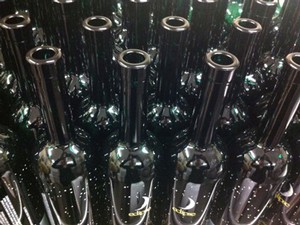 There’s always something interesting developing in the cellar. Currently, most of the 2012 reds are now in barrels, as we pumped older reds from barrels to be filtered and bottled. We just bottled Game Bird Red and 2010 Eclipse Red. Next week, we will bottle 2010 Ingle Vineyard Pinot Noir and 2011 Ingle Vineyard Chardonnay. The 2012 whites are being cold and protein stabilized, we plan to bottle these sometime in June. We also have some specially selected Reserve wines for which I’m particularly excited about this spring: 2011 Baco Noir, 2011 Blaufränkisch, 2012 Pinot Gris and 2012 Gewurztraminer. Yes, Baco Noir is almost there, as many customers have been asking for it for a while.
There’s always something interesting developing in the cellar. Currently, most of the 2012 reds are now in barrels, as we pumped older reds from barrels to be filtered and bottled. We just bottled Game Bird Red and 2010 Eclipse Red. Next week, we will bottle 2010 Ingle Vineyard Pinot Noir and 2011 Ingle Vineyard Chardonnay. The 2012 whites are being cold and protein stabilized, we plan to bottle these sometime in June. We also have some specially selected Reserve wines for which I’m particularly excited about this spring: 2011 Baco Noir, 2011 Blaufränkisch, 2012 Pinot Gris and 2012 Gewurztraminer. Yes, Baco Noir is almost there, as many customers have been asking for it for a while.
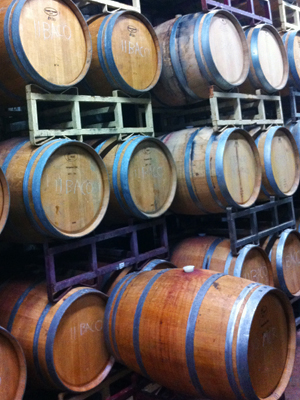 The 2012 vintage will be Heron Hill’s first Pinot Gris and Gewurztraminer ever! We are very excited about these two wines and plan to release around 200 cases each. Pinot Gris, also known Pinot Grigio, can be a very shy wine. I have found our 2012 Reserve Pinot Gris to be very different than any Pinot Grigio I have encountered. Our Pinot Gris is very expressive on the nose and complex with tropical fruit and cherry blossom notes.
The 2012 vintage will be Heron Hill’s first Pinot Gris and Gewurztraminer ever! We are very excited about these two wines and plan to release around 200 cases each. Pinot Gris, also known Pinot Grigio, can be a very shy wine. I have found our 2012 Reserve Pinot Gris to be very different than any Pinot Grigio I have encountered. Our Pinot Gris is very expressive on the nose and complex with tropical fruit and cherry blossom notes.
Many people have asked for a Gewurztraminer since I started at Heron Hill in 2009. We will release the wine in just a couple months! For me, the nose is lychee, characteristic of the varietal, but it also has some floral notes, making the bouquet very elegant.
On a personal note, I am looking forward to visiting my friends and family in southern France at the end of March. So much for trying to lose some weight! When I visit, each meal is a feast, easy on the greens but heavy on the fat and tasty meats and cheeses. It feels really good to go back to where I grew up…my grandparents’ villages, and my grandfather’s vineyards where I used to work with my father. Although so much as changed or looks very different, I still love to return to these locations where I savor the memories.
It's a Winemaker's Life in December
The fermentations of the 2012 wines can dwell into December for some batches of Riesling and Late harvests. For the white varietals, it is not a bad thing to have a slow fermentation: it gives the wine more complexity and preserves the volatile aromas. As long as the sugar content is going down, I am not very worried. Some winemakers have their wines ferment until late spring.
The white wines which have completed the alcoholic fermentation are then racked off the lees a couple of times before being cold and protein stabilized. By chilling the wines at around 28 degrees F, tartaric acid and potassium ions naturally contained in grape juice react together and form tartrates, the little crystals you might have seen in a white or rosé wine that was thrown in the freezer for a quick chill, or the cork of a bottle of red wine. Tartrates are not armful; they just look weird in a clear white wine and feel like sand in your mouth. The tartrates settle to the bottom of the tank and are removed from the wine. Heat or protein stability is obtained by getting rid of the proteins contained in the wine by adding bentonite, a sort of clay. The proteins weighed down by the bentonite settle to the bottom of the tank and are removed from the wine. After a couple of filtrations, the heat and cold stable wine is ready to be bottled during the summer.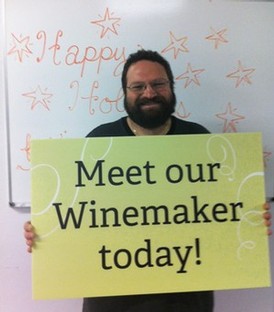
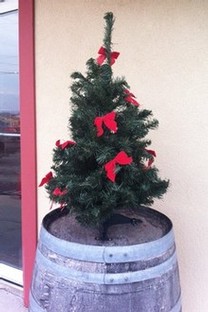
The red wines don’t have to go through heat and cold stabilization, although some winemakers may choose to do so. Over the winter, the reds go through a secondary fermentation, called Malo-lactic fermentation. Malo-lactic bacteria eat malic acid, naturally contained in grape juice, and produce lactic acid, which is a softer acid than malic acid. This secondary fermentation makes the wine more stable against spoilage and makes the wine softer. We do not have our white wines go through Malo-lactic fermentation in order to preserve the natural crisp acidity of the Rieslings and chardonnays and other white wines. It’s all about balance!
In the vineyard, we are plowing to cover the base of the trunks of the vines to protect them from the harsh winter. We are fixing wires, posts and such before the soil freezes. Pruning starts with the New Year and lasts throughout March.
For the Holidays, my wife and I return to Long Island where her relatives reside. We traditionally celebrate with the Italian “Feast of the seven Fishes.” You might have guessed it: it’s all seafood! I usually bring the wines, of course: Heron Hill Muscat, Dry and Semi-Dry Riesling, Ingle Vineyard Cabernet Franc and Eclipse Red for the red wine drinkers, and I better not forget my mother in law’s favorite: Late Harvest Vidal Blanc. It is the occasion for us to see all our cousins, at least once a year, catch up, and have a great time, playing pool and poker. These guys can be tough! Happy Holidays, and drink responsibly.
The Great Story of Muscat
Muscat grape is considered one of the oldest, if not the oldest, grape domesticated by man. Its origin is unknown but it could come from the Middle East or the Arabian Peninsula where it could have been cultivated about 4,000 years ago, if not longer. It is believed that traders and/or soldiers brought the Muscat vine from the Arabian Peninsula to the Mediterranean: soon Egyptians, Greeks and Romans not only grew it but also took the vines with them during their conquests and spread it all around the Mediterranean. It then was propagated throughout all of Europe, from Portugal to Russia. In the Nineteenth Century, Muscat was introduced in South Africa, Australia and New Zealand.
Because of such a long heritage, there are at least two hundred different varieties containing the name Muscat. They belong to the Vitis Vinifera family. Examples?
Muscat Blanc à Petits Grains is commonly used in Asti Spumante (sparkling) and Muscat De Frontignan (Vin Doux Naturel). It also has many different names: Muscat d’Alsace, Muskatelle, and Moscato Bianco. Moscato Bianco in Italy is used to make the sweet, effervescent Moscato d’ Asti wine that is currently on trend and widely referred to in the United States as just Moscato.
Muscat of Alexandria gets its name from the Egyptian City of Alexandria, one of the most advanced cities of its time, with the first and biggest Librairy, before tsunamis, earthquakes and invasions destroyed it. This Muscat grape can be found in Moscatel wines, sherry wines, or as table grape and raisin.
Muscat Ottonel, also called Moskately, is used in dessert wines in Austria and Eastern Europe.
Muscat of Hamburg has a darker color and is used as table grape or dessert wine in Eastern Europe and Northern Italy.
To make it even more confusing, each region can have a different name for the same grape.
Apart from settle variations, all these varieties of Muscat tend to express the same aromatic characteristic. The compound Linalol present in the juice is very aromatic and is described as musqué in French. It is reminiscent of Lychee, an Asian fruit you can find in…Asian Cuisine. It is somewhat similar to the aroma of a Gewurztraminer, which may be a sign of a Family tie between the two varietals. The spicy note in the Muscat bouquet is not too far fetched from the spicy aroma of the Gewurztraminer, Gewurz meaning spice in German.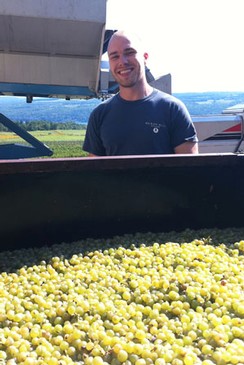
At Heron Hill Winery, we grow Muscat Ottonel and we added a new planting of Muscat Blanc. Muscat Ottonel is used in the production of Dessert wines, but grape production has been so limited that we have not made a Muscat Late Harvest in a couple of years. Hopefully, with the Muscat Blanc coming into production in a couple of years, we will be able to produce a Muscat Late Harvest.
Crushing Muscat on September 12, 2012:
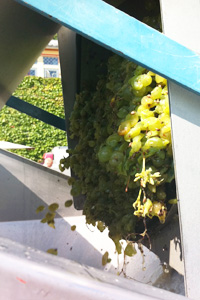
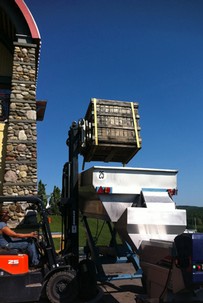
Some of our grapes come from various grape growers throughout the Finger Lakes (Keuka, Seneca, Cayuga and Skaneateles Lakes). One of our growers on the west side of Seneca Lake has planted a vineyard of Valvin Muscat. Valvin Muscat is a cross between Muscat Ottonel (Vitis Vinifera) and a hybrid called Muscat du Moulin. It was developed at Cornell University in Geneva, NY. Valvin Muscat is a hardier variety than most Vinifera, and exudes the same typical lychee and spicy aromas as any European Muscat.
With these grapes, we produce the Heron Hill Muscat. The first release was in 2010 with the 2009 vintage. It sold out in a few months! We are now about to run out of the 2010 vintage, and we will then switch to the 2011, which has the new Heron Hill Classic label and a screw cap! So far, the Heron hill staff has been very excited about this new release about to happen. Just twenty-four hours after bottling, we offered a pre-release taste of the 2011 Muscat at our Label Launch Party on August 1st. It was very well received on a hot summer afternoon paired with roasted turkey and mango-cilantro coulis on a slice of baguette.
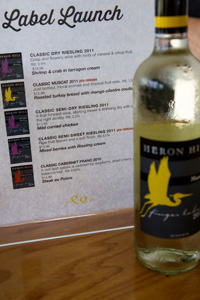
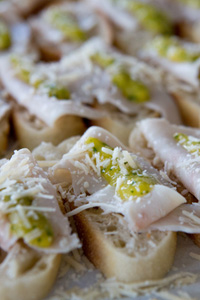
Burning Bales and Spring Barrel Tastings
Pyromaniacs!
Since we have had a mild winter, allowing us to get a lot of work done in the vineyard besides pruning, bud break has been early. And an early bud break means that the open buds and young leaves are very sensitive to frost. When the bud is swelling up or is “in the cotton”, it can endure temperatures down to 28 F before seeing significant damage. It was the case in early April. But once the young leaves are apparent, the threshold rises to 30 to 32 F.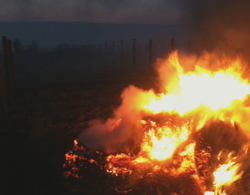
Well, for the last three days, we have had brutal cold temperatures at night. Tonight is technically Monday morning, April 30, 3 o’clock in the morning. It is the third night we have been burning hay bales in order to protect the young buds. Friday night the lower temperature measured in the vineyard was 25 F, Saturday night the thermometer plummeted to 23 F at five o’clock in the morning, and right now we are at 30 F and expecting the temperature to drop to 28 F by five o’clock.
Needless to say, we got hit by spring frost! The damage is hard to estimate at the moment on the primary buds. Some of them are brown and crisp on the outside, so we can hope that only the outer leaves have been touched. Some others are very crispy: they are obviously lost. Saturday night being the coldest, some of our neighbors were also burning hay bales.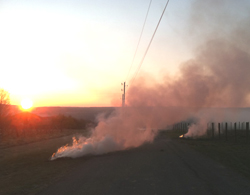
Doing so, as long as the wind velocity is minimal, creates a foggy blanket above the vineyard which limits the loss of heat from the ground, limiting the frost damage. Too much wind can have a dramatic effect: the warm air created by the burning moving out, it sucks in more cold air from underneath, accentuating the frost damage.
At ingle Vineyard, John, Nate and Kyle also burned hay over the weekend. The temperature there did not drop as much as here at the winery. I have good hope that the damage there is minimal. John found himself a sweet spot for his vineyard, on Canandaigua Lake!

So, for the last three nights, with Zac and Ethan, we have been staying up all night, burning hay bales, and replenishing the vineyard with new ones during the day.
Saturday, April 28 was the first round of our Wine club members VIP tour. The second round is scheduled for May 12. The event is reserved to our Wine Club members and their guests: after meeting in the tower around a glass of Chardonnay, Muscat or Cabernet franc Reserve, the group headed down to the cellar where we sampled a couple of tanks and a few barrels. Lunch was prepared by Mike “Ollie” Oliver, Blue Heron Café Director, and paired with a selection of Heron Hill and Ingle Vineyards’ wines. And I added a sneak preview of soon to be released wines. Ollie surprised us with a few discoveries of his own, and a to die for dessert! I don’t want to ruin the surprise for the Club members coming to visit us in a couple of weeks. I personally had a blast meeting newer members and seeing some die-hard fans whom I had met last year during this very same event. It was great for me to share wines “in the making” and explain the stage a particular wine we tasted was in and what was still to be done for its completion. Everyone left happy, and so was I! I always have a good time when I talk about wine and share my passion with others! While enjoying some delicious food…
Oh well, it’s time to get back outside and check on those hay bales again. The forecast for the rest of the week looks pretty warm, for now.
Joyeux Noël from our Winemaker, Bernard
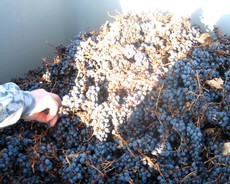 As of last week, we are officially done with harvest. The last crop we picked is a Late Harvest Cabernet Franc we had let hang on the vines at Ingle Vineyard. There will be no Icewine this year, but we are very pleased with the Late Harvest Vidal, the Late Harvest Riesling from Ingle Vineyard and the Late Harvest Cabernet Franc.
As of last week, we are officially done with harvest. The last crop we picked is a Late Harvest Cabernet Franc we had let hang on the vines at Ingle Vineyard. There will be no Icewine this year, but we are very pleased with the Late Harvest Vidal, the Late Harvest Riesling from Ingle Vineyard and the Late Harvest Cabernet Franc.
In the vineyard, pruning will start with the New Year. In the cellar, we are monitoring the Malolactic fermentations on the 2011 reds, and starting to stabilize the 2011 whites so they will be ready to be bottled in the spring. The 2011 harvest has been one of the biggest harvests at Heron Hill Winery, and somewhat challenging because of the weather conditions and a cellar filling very quickly with freshly pressed juice. Now we have more time to take a more regular pace, after the excitement of the harvest season. But there is always something to do on a vineyard and in a cellar.
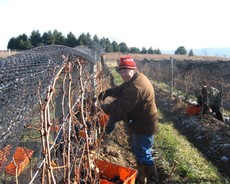 As the holidays approach, I would like to take the opportunity to wish you all a “Joyeux Noël” (Merry Christmas) and a “Bonne Année 2012” (Happy New Year 2012). My wife and I will spend Christmas on Long Island with her Family. Being Italians, they have “The Feast of the Seven Fishes” every Christmas Eve. It is an occasion to see relatives we do not have the chance to visit as often as we wish. There is not that much fish though, mostly lobster tails, shrimp and clams in different sauces and styles. I usually bring some Heron Hill Semi-Dry Riesling, which tends to please everybody. The Heron Hill Muscat remains the favorite for the appetizers.
As the holidays approach, I would like to take the opportunity to wish you all a “Joyeux Noël” (Merry Christmas) and a “Bonne Année 2012” (Happy New Year 2012). My wife and I will spend Christmas on Long Island with her Family. Being Italians, they have “The Feast of the Seven Fishes” every Christmas Eve. It is an occasion to see relatives we do not have the chance to visit as often as we wish. There is not that much fish though, mostly lobster tails, shrimp and clams in different sauces and styles. I usually bring some Heron Hill Semi-Dry Riesling, which tends to please everybody. The Heron Hill Muscat remains the favorite for the appetizers.
Traditionally, my mom in France makes the “Bûche de Noël” (Yule log). It is not an easy task to undertake. I have tried to make it myself a couple of years ago: the taste was great, but the cake collapsed and looked more like a layered cake than a round log. But my mom also makes festive dishes that are much easier, which I am able to recreate, given that my mom never uses measuring cups. She was a chef for forty years and never used any of these. She would say: “use a small glass of flower, like the ones we use for dinner, the small ones, not the tall glasses, and overfill it up a little but not too much… Well, you’ll see…” Thanks mom, I am so glad I called! It is so clear to me now! So, most of my recipes are done by taste.
For the Holidays, my mom always made Flambée Shrimp. It is so easy and spectacular too. Here’s her recipe:
Flambée Shrimp for the holidays
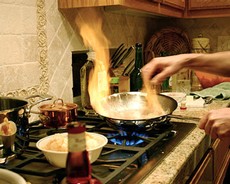 First, sauté some chopped garlic in a frying pan with olive oil (which can be replaced by butter). When the garlic is slightly brown, add the raw shrimp and sauté them on one side for a couple of minutes. Flip them and sauté them on their other side for another couple of minutes, or until almost cooked (can’t you feel the resemblance with one of my mom’s recipes?) You can add some salt and pepper to taste during this step. In the meantime, in a small saucepan, warm up some Whiskey or Rum, about 1/4 cup. When the Whiskey is smoking (it does not have to be boiling), TURN OFF ALL BURNERS ON THE STOVE (you will see how important that is!), place the frying pan in safe surroundings, clear of flammable objects (I usually leave the pan on the stove as it is a pretty safe spot in my kitchen), pour the smoking Whiskey over the shrimp, and with a long match, ignite the Whiskey. The alcohol will burn with a blue light. You can wait until all the alcohol has burned down, or you can stop the flambée by covering the frying pan with its cover. That will give an extra kick to the dish. If we have guests (I also make that dish just for my wife and I occasionally), they often get awed by the show!
First, sauté some chopped garlic in a frying pan with olive oil (which can be replaced by butter). When the garlic is slightly brown, add the raw shrimp and sauté them on one side for a couple of minutes. Flip them and sauté them on their other side for another couple of minutes, or until almost cooked (can’t you feel the resemblance with one of my mom’s recipes?) You can add some salt and pepper to taste during this step. In the meantime, in a small saucepan, warm up some Whiskey or Rum, about 1/4 cup. When the Whiskey is smoking (it does not have to be boiling), TURN OFF ALL BURNERS ON THE STOVE (you will see how important that is!), place the frying pan in safe surroundings, clear of flammable objects (I usually leave the pan on the stove as it is a pretty safe spot in my kitchen), pour the smoking Whiskey over the shrimp, and with a long match, ignite the Whiskey. The alcohol will burn with a blue light. You can wait until all the alcohol has burned down, or you can stop the flambée by covering the frying pan with its cover. That will give an extra kick to the dish. If we have guests (I also make that dish just for my wife and I occasionally), they often get awed by the show!
I traditionally use raw shrimp with their shell, and they are eaten as an appetizer. They are quite tasty on their own, but I like to make a homemade Mayonnaise or Aioli.
Homemade Maynnaise or Aioli for the Flambée Shrimp
 Again, it is very simple: put one to two egg yokes in a bowl, add a pinch of salt and pepper. Then, with a small whisk, start whisking and add olive oil VERY SLOWLY. Towards the end, you can add finely chopped fresh garlic to make it an Aioli (“Ail” means garlic in French). Just dip the shelled shrimp in the Aioli, and enjoy! Here too, the Heron Hill Semi Dry Riesling or Muscat complement the dish very well.
Again, it is very simple: put one to two egg yokes in a bowl, add a pinch of salt and pepper. Then, with a small whisk, start whisking and add olive oil VERY SLOWLY. Towards the end, you can add finely chopped fresh garlic to make it an Aioli (“Ail” means garlic in French). Just dip the shelled shrimp in the Aioli, and enjoy! Here too, the Heron Hill Semi Dry Riesling or Muscat complement the dish very well.
I have made a variation of this recipe to make a main dish at last Valentine’s Day dinner I had with my wife at our house. I first sautéed the shrimp in garlic and olive oil until almost cooked, then set them aside in a plate. I then sautéed a little more garlic in Olive oil, and then added some scallops. I did not want to mess up the cooking of the scallops. That is why I decided to cook the shrimp and the scallops separately. Better be safe than sorry on a romantic date… When they were almost ready, I added the shrimp back in the pan with the scallops and then poured the warm spiced Rum, ignited it, and after the alcohol burned off, I poured the shrimp and scallops over pasta. Et voilà! It was quick, efficient, and it looked like I was a skilled French chef! Because the flavors were not as prominent with the pasta, Eclipse White or Ingle Vineyard Chardonnay pair extremely well with the dish.
Enjoy the holidays!
Our first week with the screw cap machine
 In the spring we were praying for the rain to stop, and now we are praying for the rain to come back and visit us! Growing grapes involves a lot of dancing. The vines could use some water, but on the bright side, the vineyard is fungus free. It looks like we will have more fruit than last year, making Zach, our vineyard manager pretty excited. At this point, we are catching up with all kind of work in the vineyard. The grapes are at the “berry touch” stage, which means that the berries are slowly growing and now touching each other, closing the cluster. The berries are still very hard, like pebbles. Next, we will be seeing the berries go into veraison, when they change color, from green to yellow or purple, depending on the varietal. It will be in a few weeks. Then, they will continue to grow in size and soften during maturation.
In the spring we were praying for the rain to stop, and now we are praying for the rain to come back and visit us! Growing grapes involves a lot of dancing. The vines could use some water, but on the bright side, the vineyard is fungus free. It looks like we will have more fruit than last year, making Zach, our vineyard manager pretty excited. At this point, we are catching up with all kind of work in the vineyard. The grapes are at the “berry touch” stage, which means that the berries are slowly growing and now touching each other, closing the cluster. The berries are still very hard, like pebbles. Next, we will be seeing the berries go into veraison, when they change color, from green to yellow or purple, depending on the varietal. It will be in a few weeks. Then, they will continue to grow in size and soften during maturation.
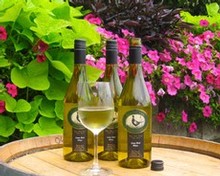 Wednesday was our first bottling with screw caps. The chosen first wine was the Game Bird White. Game Bird Red is to follow next week. We chose the Game Bird Series to start because the wines do not require any bottle aging: they are ready to be enjoyed as soon as they recover from bottle shock. In a few months, we will use screw caps on some wines from the Classic Line, like the Rieslings, the Chardonnay and the Muscat. The red wines benefit from some aging in the bottle, so we will keep using natural corks on these wines. Screw cap closures help preserve the freshness and fruitiness of the wines. Natural corks allow small amounts of air to reach the wine through the cork, inducing the slow oxidation which aging actually is. Some screw cap closures allow some oxygen to get in the bottle, mimicking a natural cork. Maybe we will look into these in the future. But the unique sound that a natural cork makes when opening a bottle of fine wine is a very important part of the whole experience, and so far scientists have not been able to recreate this pop for a screw cap. I have tried to make that sound, but it just sounds silly.
Wednesday was our first bottling with screw caps. The chosen first wine was the Game Bird White. Game Bird Red is to follow next week. We chose the Game Bird Series to start because the wines do not require any bottle aging: they are ready to be enjoyed as soon as they recover from bottle shock. In a few months, we will use screw caps on some wines from the Classic Line, like the Rieslings, the Chardonnay and the Muscat. The red wines benefit from some aging in the bottle, so we will keep using natural corks on these wines. Screw cap closures help preserve the freshness and fruitiness of the wines. Natural corks allow small amounts of air to reach the wine through the cork, inducing the slow oxidation which aging actually is. Some screw cap closures allow some oxygen to get in the bottle, mimicking a natural cork. Maybe we will look into these in the future. But the unique sound that a natural cork makes when opening a bottle of fine wine is a very important part of the whole experience, and so far scientists have not been able to recreate this pop for a screw cap. I have tried to make that sound, but it just sounds silly.
 Another excitement in the cellar is the arrival of Dan Pantaleo as the new Assistant Winemaker. I worked with Dan on Long Island for four years. He has been with us for almost two months now, and he is adjusting nicely to a new environment. He has plenty of work in the cellar and is very helpful at keeping me grounded. He is getting the wines cold and heat stabilized and ready to be bottled over the month of August and September. Welcome, Dan!
Another excitement in the cellar is the arrival of Dan Pantaleo as the new Assistant Winemaker. I worked with Dan on Long Island for four years. He has been with us for almost two months now, and he is adjusting nicely to a new environment. He has plenty of work in the cellar and is very helpful at keeping me grounded. He is getting the wines cold and heat stabilized and ready to be bottled over the month of August and September. Welcome, Dan!
Watch video and see pictures of the screw cap machine here.
Wine Club barrel tasting & tour event
Last week we had what seemed to be spring’s prelude, only to have the cold come back. Looks like spring wants to pop out, but winter is not quite done with us yet. In the vineyard, we spent the month of March pruning the Riesling, then the Muscat. The weather hasn’t been cooperating too much, but we’re getting by. The couple of warm days we had last week were enough to make the vines “cry”: the sap is flowing in the plant, sign that the vine is getting out of its dormancy, dawn of a new growing season. In the cellar, Brian keeps pushing things along: the 2010 reds are in barrels for the most part, and we are catching up on our bottling, if this machine would only co-operate…
On April 22nd, students from SUNY Morrisville will be visiting us. Brian will give them a tour of the winery, since I will be in France visiting my family whom I haven’t seen for over three years.
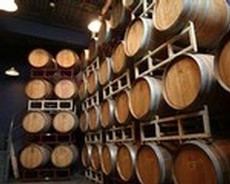 On April 30th and May 7th, we will be hosting an event for our wine club members. It will be a three hour event, including a cellar tour with a barrel tasting, wine tasting in the tower (weather permitting), and a tasty luncheon prepared by Ollie, The Blue Heron Café’s chef, which should open for the season by the end of May. Depending on the weather, we will also take our wine club members out on the vineyard for an overview: we might be able to see how the new shoots are evolving. It is hard to tell now when budbreak will be, though, and how early or late the season will actually start. Last year we were burning hay bails against spring frost from late April until early May.
On April 30th and May 7th, we will be hosting an event for our wine club members. It will be a three hour event, including a cellar tour with a barrel tasting, wine tasting in the tower (weather permitting), and a tasty luncheon prepared by Ollie, The Blue Heron Café’s chef, which should open for the season by the end of May. Depending on the weather, we will also take our wine club members out on the vineyard for an overview: we might be able to see how the new shoots are evolving. It is hard to tell now when budbreak will be, though, and how early or late the season will actually start. Last year we were burning hay bails against spring frost from late April until early May.

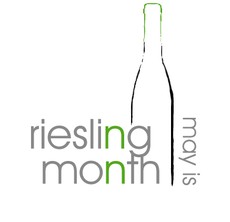 We’ll be participating with Spring into Riesling in April and May is Riesling month, we will be showcasing a Vertical Ingle Vineyard Riesling tasting. We’ll let you know in our newsletter (sign up here). This special tasting will also be available at our two satellite locations, on Seneca Lake and at Bristol on Canandaigua Lake.
We’ll be participating with Spring into Riesling in April and May is Riesling month, we will be showcasing a Vertical Ingle Vineyard Riesling tasting. We’ll let you know in our newsletter (sign up here). This special tasting will also be available at our two satellite locations, on Seneca Lake and at Bristol on Canandaigua Lake.
We are slowly getting away from winter, which means we are gearing up for the season, in the vineyard, in the cellar, where it never stops, and in the tasting room. Sometimes the production crew gets to participate with helping to set up events, but when the party’s over, we get back to the cellar or the vineyard. It’s nice to take a break and get involved in a few key events. Group effort! Click here for details if you’re interested in attending the wine club barrel tasting and tour event.

